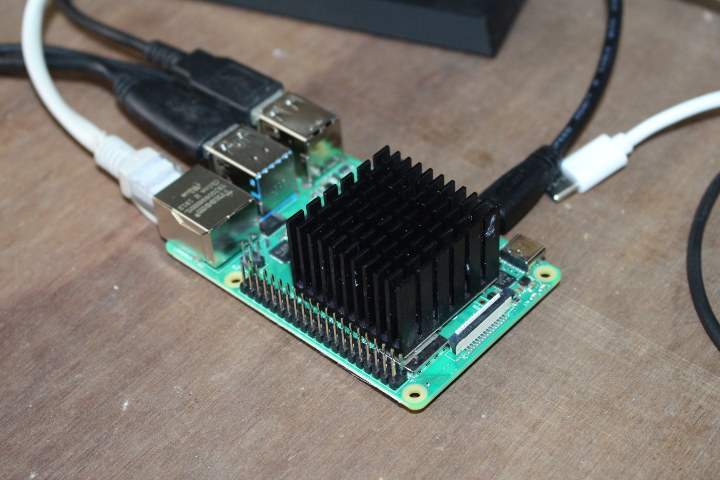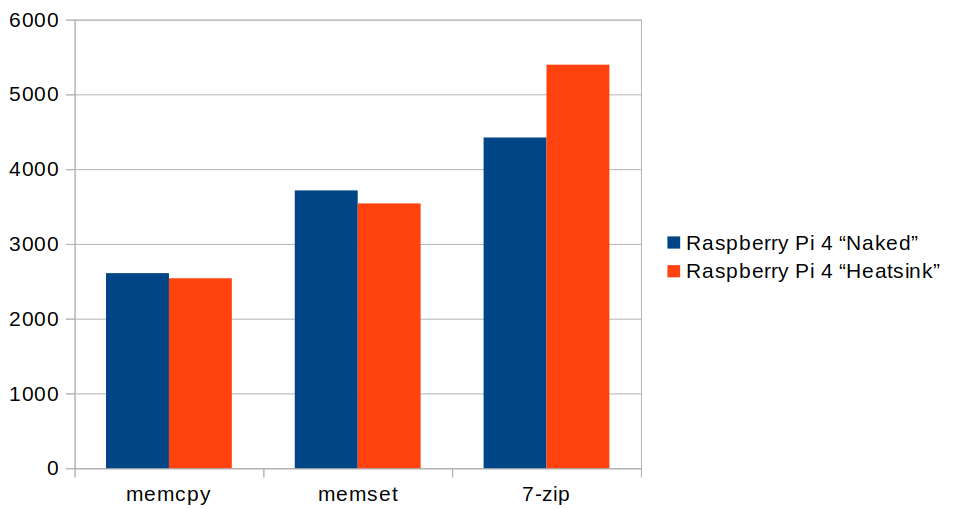A few days ago, I ran some benchmarks in Raspberry Pi 4, and quickly found out that using the board without a cooling solution will cause serious performance issues, as in some cases my board was slower than Raspberry Pi 3 model B due to severe overheating.
After playing with LibreELEC yesterday, I’ve now reinstalled Raspbian Buster Desktop on the board, and fitted it with a largish heatsink and some old thermal paste.

So I’ll run benchmarks again with and without heatsink. I’ll only run sbc-bench this time.
SBC Bench Installation
Open a terminal windows or connect to the board through SSH and run:
|
1 |
wget https://raw.githubusercontent.com/ThomasKaiser/sbc-bench/master/sbc-bench.sh |
Raspbian Buster will automatically fetch the latest operating systems packages upon first boot, but apparently not the latest firmware:
|
1 2 3 4 |
/opt/vc/bin/vcgencmd version Jun 20 2019 16:04:31 Copyright (c) 2012 Broadcom version 407b1da8fa3d1a7108cb1d250f5064a3420d2b7d (clean) (release) (start) |
So I ran rpi-update to get the very latest firmware as well, and rebooted the board:
|
1 2 3 4 |
/opt/vc/bin/vcgencmd version Jun 26 2019 17:42:42 Copyright (c) 2012 Broadcom version 1186f932808ed601ddd583a30a3ce055477b1a26 (clean) (release) (start) |
Normally, you should not have to do it, but Raspberry Pi 4 is really new, so I expect frequent changes at the beginning. Read warning in rpi-update:
WARNING: ‘rpi-update’ updates to pre-releases of the linux
kernel tree and Videocore firmware.‘rpi-update’ should only be used if there is a specific
reason to do so – for example, a request by a Raspberry Pi
engineer.
Results with heatsink
Room temperature: 28°C. Uptime, idle temperature, and CPU freq:
|
1 2 3 4 5 6 |
pi@raspberrypi:~ $ uptime 17:00:51 up 2 min, 3 users, load average: 0.37, 0.33, 0.13 pi@raspberrypi:~ $ /opt/vc/bin/vcgencmd measure_temp temp=60.0'C pi@raspberrypi:~ $ /opt/vc/bin/vcgencmd measure_clock arm frequency(48)=600169920 |
Benchmark results:
|
1 2 3 4 5 6 7 8 9 10 11 12 13 14 15 16 17 18 19 20 21 22 23 24 25 26 27 28 29 30 |
sudo /bin/bash ./sbc-bench.sh -c sbc-bench v0.6.7 Installing needed tools. This may take some time... Done. Checking cpufreq OPP... Done. Executing tinymembench. This will take a long time... Done. Executing OpenSSL benchmark. This will take 3 minutes... Done. Executing 7-zip benchmark. This will take a long time... Done. Checking cpufreq OPP... Done. It seems neither throttling nor frequency capping has occured. Memory performance: memcpy: 2540.1 MB/s memset: 3541.8 MB/s (0.4%) 7-zip total scores (3 consecutive runs): 5520,5329,5342 OpenSSL results: type 16 bytes 64 bytes 256 bytes 1024 bytes 8192 bytes 16384 bytes aes-128-cbc 62337.00k 76517.57k 83103.06k 84397.40k 85174.95k 85103.96k aes-128-cbc 62385.73k 76696.34k 82954.50k 84633.94k 85035.69k 85169.49k aes-192-cbc 56248.36k 67203.52k 72105.90k 73188.35k 73454.93k 73564.16k aes-192-cbc 56125.90k 67502.17k 71853.82k 73263.45k 73610.58k 73422.17k aes-256-cbc 51001.95k 59901.03k 63540.65k 64509.95k 64828.76k 64875.18k aes-256-cbc 50713.81k 60062.34k 63573.93k 64478.89k 64927.06k 64782.34k Full results uploaded to http://ix.io/1MUi. Please check the log for anomalies (e.g. swapping or throttling happenend) and otherwise share this URL. |
Frequency/temperature monitoring during 7-zip:
|
1 2 3 4 5 6 7 8 9 10 11 12 13 14 15 16 17 18 19 20 21 |
pi@raspberrypi:~ $ sudo ./sbc-bench.sh -m Time fake/real load %cpu %sys %usr %nice %io %irq Temp VCore 17:21:17: 1500/1500MHz 4.00 25% 1% 22% 0% 1% 0% 76.9°C 0.8613V 17:21:22: 1500/1500MHz 4.00 98% 1% 96% 0% 0% 0% 78.4°C 0.8613V 17:21:27: 1500/1500MHz 4.08 69% 4% 64% 0% 0% 0% 78.4°C 0.8613V 17:21:37: 1500/1500MHz 4.07 82% 6% 56% 0% 19% 0% 76.0°C 0.8613V 17:21:46: 1500/1500MHz 4.43 82% 3% 35% 0% 43% 0% 75.0°C 0.8613V 17:21:51: 1500/1500MHz 4.31 33% 3% 13% 0% 16% 0% 73.0°C 0.8613V 17:21:56: 1500/1500MHz 4.13 49% 1% 47% 0% 0% 0% 73.5°C 0.8613V 17:22:02: 1500/1500MHz 4.12 84% 3% 65% 0% 16% 0% 77.9°C 0.8613V 17:22:07: 1500/1500MHz 4.27 51% 2% 49% 0% 0% 0% 75.5°C 0.8613V 17:22:12: 1500/1500MHz 4.25 89% 3% 85% 0% 0% 0% 77.4°C 0.8613V 17:22:17: 1500/1500MHz 4.22 94% 2% 91% 0% 0% 0% 78.9°C 0.8613V 17:22:22: 1500/1500MHz 4.13 80% 3% 77% 0% 0% 0% 78.4°C 0.8613V 17:22:27: 1500/1500MHz 4.12 96% 1% 94% 0% 0% 0% 79.4°C 0.8613V 17:22:32: 1500/1500MHz 3.87 77% 4% 72% 0% 0% 0% 77.9°C 0.8613V 17:22:37: 1500/1500MHz 3.80 84% 3% 80% 0% 0% 0% 78.4°C 0.8613V 17:22:52: 1500/1500MHz 4.53 91% 10% 71% 0% 9% 0% 76.4°C 0.8613V 17:22:58: 1500/1500MHz 4.33 54% 3% 36% 0% 14% 0% 75.5°C 0.8613V 17:23:03: 600/ 600MHz 4.30 77% 4% 61% 0% 11% 0% 76.0°C 0.8613V 17:23:08: 1500/1500MHz 4.28 85% 6% 76% 0% 2% 0% 76.9°C 0.8613V |
It never went over the maximum 85°C temperature, and always under 80°C.
Results without heatsink
Now let’s remove the heatsink, reboot the board and wait a few minutes.
Room temperature: 28°C. Idle temperature:
|
1 2 3 4 5 6 |
pi@raspberrypi:~ $ uptime 17:30:16 up 4 min, 4 users, load average: 0.05, 0.18, 0.09 pi@raspberrypi:~ $ /opt/vc/bin/vcgencmd measure_temp temp=64.0'C pi@raspberrypi:~ $ /opt/vc/bin/vcgencmd measure_clock arm frequency(48)=600169920 |
So 4°C more at idle after about 3 minutes uptime without heatsink..
Benchmark results:
|
1 2 3 4 5 6 7 8 9 10 11 12 13 14 15 16 17 18 19 20 21 22 23 24 25 26 27 28 29 30 |
sudo /bin/bash ./sbc-bench.sh -c sbc-bench v0.6.7 Installing needed tools. This may take some time... Done. Checking cpufreq OPP... Done. Executing tinymembench. This will take a long time... Done. Executing OpenSSL benchmark. This will take 3 minutes... Done. Executing 7-zip benchmark. This will take a long time..../sbc-bench.sh: line 600: 26143 Killed taskset -c 0 "${SevenZip}" b -mmt 1 >> ${TempLog} Done. Checking cpufreq OPP... Done. ATTENTION: Throttling and frequency capping has occured. Check the log for details. Memory performance: memcpy: 2606.8 MB/s (0.1%) memset: 3715.6 MB/s (0.6%) 7-zip total scores (3 consecutive runs): 5010,4199,4060 OpenSSL results: type 16 bytes 64 bytes 256 bytes 1024 bytes 8192 bytes 16384 bytes aes-128-cbc 62618.39k 76668.97k 83098.11k 84445.18k 85207.72k 85256.87k aes-128-cbc 55602.85k 73856.09k 82227.71k 84523.35k 85125.80k 85185.88k aes-192-cbc 56274.63k 67320.43k 72087.98k 73332.39k 73457.66k 73602.39k aes-192-cbc 50073.79k 65060.65k 71326.63k 73138.52k 73220.10k 73400.32k aes-256-cbc 50936.85k 60008.47k 63549.78k 64555.69k 64913.41k 64935.25k aes-256-cbc 50874.31k 60056.68k 63686.74k 64486.06k 64891.56k 64815.10k Full results uploaded to http://ix.io/1MUy. Please check the log for anomalies (e.g. swapping or throttling happenend) and otherwise share this URL. |
Throttling did occur, and indeed monitoring frequency and temperature during the benchmark shows temperature going close to 85°C, and real frequency dropping as low as 750 MHz to cool the system:
|
1 2 3 4 5 6 7 8 9 10 11 12 13 14 15 16 17 18 19 20 21 |
pi@raspberrypi:~ $ sudo ./sbc-bench.sh -m Time fake/real load %cpu %sys %usr %nice %io %irq Temp VCore 18:40:40: 1500/1500MHz 4.46 18% 1% 15% 0% 1% 0% 79.9°C 0.8595V 18:40:45: 1500/1500MHz 4.69 50% 2% 1% 0% 46% 0% 77.9°C 0.8595V 18:40:55: 1500/1500MHz 4.79 80% 5% 42% 0% 32% 0% 80.3°C 0.8595V 18:41:00: 1500/1500MHz 4.59 41% 3% 19% 0% 18% 0% 80.8°C 0.8595V 18:41:05: 1500/1500MHz 4.46 53% 1% 49% 0% 1% 0% 80.3°C 0.8595V 18:41:10: 1500/1000MHz 4.42 86% 2% 76% 0% 7% 0% 82.8°C 0.8595V 18:41:15: 1500/1500MHz 4.47 50% 2% 47% 0% 0% 0% 80.8°C 0.8595V 18:41:20: 1500/1000MHz 4.43 91% 1% 89% 0% 0% 0% 82.8°C 0.8595V 18:41:25: 1500/1000MHz 4.39 86% 2% 83% 0% 0% 0% 81.8°C 0.8595V 18:41:30: 1500/1000MHz 4.36 90% 1% 89% 0% 0% 0% 82.3°C 0.8595V 18:41:36: 1500/1000MHz 4.17 78% 5% 72% 0% 0% 0% 83.3°C 0.8595V 18:41:41: 1500/1000MHz 4.08 89% 2% 87% 0% 0% 0% 82.8°C 0.8595V 18:41:46: 1500/ 750MHz 4.07 93% 2% 90% 0% 0% 0% 85.2°C 0.8595V 18:41:51: 1500/1000MHz 3.91 68% 3% 64% 0% 0% 0% 83.3°C 0.8595V 18:41:56: 1500/1000MHz 3.83 82% 3% 78% 0% 0% 0% 82.3°C 0.8595V 18:42:13: 1500/1500MHz 4.64 79% 6% 47% 0% 24% 0% 81.3°C 0.8595V 18:42:19: 1500/1500MHz 4.35 32% 3% 11% 0% 17% 0% 79.9°C 0.8595V 18:42:24: 1500/1500MHz 4.16 50% 1% 48% 0% 0% 0% 82.3°C 0.8595V 18:42:29: 1500/1000MHz 3.99 80% 3% 68% 0% 9% 0% 82.3°C 0.8595V |
Comparison table and Pretty Chart
We can see that single thread benchmark are not affected by the presence of an heatsink, but the multi-threaded 7-zip compression is certainly impacted.
| Benchmark | Raspberry Pi 4 “Naked” | Raspberry Pi 4 “Heatsink” | Ratio |
| memcpy | 2608.8 | 2540.1 | 97.37% |
| memset | 3715.6 | 3541.8 | 95.32% |
| 7-zip | 4423 | 5397 | 122.02% |
| OpenSSL aes-256-cbc 16KB |
64891.56k | 64782.34k | 99.83% |
The differences for memcpy, memset, and OpenSSL are just statistical errors. But Raspberry Pi 4 with heasink is over 20% faster for 7-zip compression as it does not throttle during the test.


Jean-Luc started CNX Software in 2010 as a part-time endeavor, before quitting his job as a software engineering manager, and starting to write daily news, and reviews full time later in 2011.
Support CNX Software! Donate via cryptocurrencies, become a Patron on Patreon, or purchase goods on Amazon or Aliexpress




